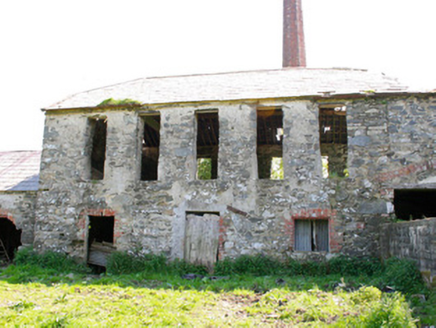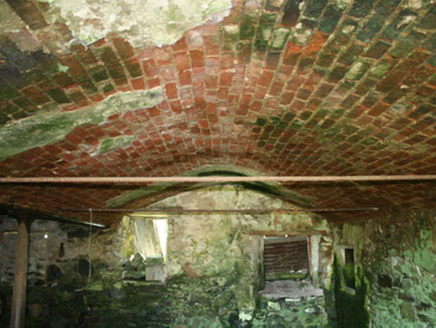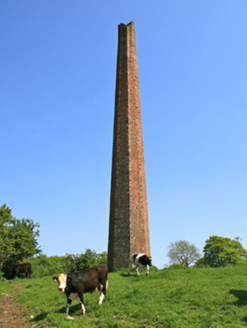Survey Data
Reg No
41402018
Rating
Regional
Categories of Special Interest
Architectural, Technical
Original Use
Mill (water)
Date
1840 - 1860
Coordinates
285864, 321559
Date Recorded
27/05/2012
Date Updated
--/--/--
Description
Attached multiple-bay, two-storey flax mill and associated detached chimney, built c.1850, aligned east-west on south bank of river. Now disused. Half-hipped slate roof, now partly missing, retaining some cast-iron gutters. Coursed rubble walls, with advanced stone eaves. Square-headed window openings, with brick surrounds to ground floor openings. Elongated window openings to first floor. Two-bay single-storey building abutting mill to east, with pitched slate roof and coursed rubble walls retaining some smooth render. Square-headed and camber-headed openings, no remaining fittings. High single-bay single-storey engine room abutting west gable of mill. Square-headed pediment, coursed rubble walls. Brick vaulting in facer bond to interior ground floor ceiling. Four-bay, two-storey building to north-west corner, probably store, having cement-rendered coursed rubble walls with dressed stone quoins visible in places. Square-headed window openings with brick surrounds and concrete sills, some breaks in wall. Free-standing chimney on rise to south of flax mill, of tapered octagonal plan and of red brick. Coping missing and deteriorating at top. Partly-buried intake flue from boiler room visible on north side. Located to south of river, and to east of late eighteenth-century corn mill and masonry bridge.
Appraisal
Although now gutted of plant and machinery, this mid-nineteenth-century former water and steam-powered flax mill survives as a reminder of the importance of the flax industry in County Monaghan. The northern province had enjoyed a strong linen trade from the late seventeenth century, serving the increasing demand for this product from England. The mill complex is of historical as well as technical interest due to the survival of the brick chimney to the south, which illustrates changing power techniques over time. Many mills would have built coal powered engines with associated chimneystacks during the latter half of the nineteenth century, which would have provided added energy output when the water supply to the mill race was low or absent. The flax mill is named on both the 1859 Griffith valuation map and the 1908 Ordnance Survey maps as Drumleek Flax Mill and chimney, and a mill race is shown running parallel to the river to the north-west of the mill. The 1861 Griffith Valuation described the premises as 'flax mill and offices' operated by Parker McWatty and rated at £40. McWatty also operated a nearby corn mill at Drumleek bridge. The large complex acts as a landmark in the landscape, especially notable for the tall brick chimney. The mill is picturesquely located to the east of a double-arch masonry bridge to the river and is a significant part of the architectural and industrial heritage of County Monaghan.









